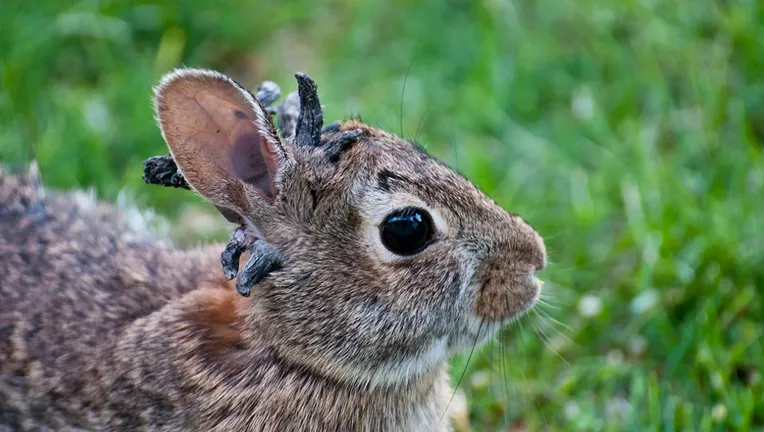Reports out of Fort Collins, Colorado, have startled residents: wild cottontail rabbits are showing odd, black, tentacle‑ or horn‑like growths sprouting from their heads and around their mouths. Photos look unsettling—some people have dubbed the animals “Frankenbunnies”—but wildlife officials say the cause is familiar. The condition is linked to a rabbit‑specific virus that can create elongated, keratinous growths that look like spikes or tentacles. Below, we break down what people are seeing, what the science says, and what Coloradans should (and should not) do if they encounter an affected rabbit. :contentReference[oaicite:0]{index=0}
What People Are Seeing in Fort Collins
Local coverage first drew attention to the sightings, noting that multiple rabbits in Fort Collins appeared with dark protrusions clustered on the head and face. The images traveled quickly through neighborhood groups and social feeds, raising understandable concern about animal welfare and public safety. Officials have confirmed that these growths are consistent with a known rabbit virus and are not a new species, mutation, or cross‑species infection. :contentReference[oaicite:1]{index=1}
The Cause: A Rabbit‑Specific Papilloma Virus
Colorado Parks and Wildlife (CPW) identifies the culprit as a papilloma virus that affects rabbits—often described as the cottontail rabbit papillomavirus or Shope papilloma virus. According to CPW, the infection is typified by black nodules on the skin, usually on the head. As the lesions enlarge and harden, they can elongate and take on a horn‑like appearance, which is why casual observers describe “spikes,” “quills,” or “tentacles.” While the look can be shocking, CPW notes most infected wild cottontails survive the infection and the growths may eventually regress. :contentReference[oaicite:2]{index=2}
Is It Dangerous to People or Pets?
Experts emphasize an important point: this virus is species‑specific. It does not infect humans, dogs, or cats, and there is no evidence that simply seeing an affected rabbit poses any health risk to people. However, domestic rabbits can be vulnerable—especially if they are housed outdoors where they might encounter wild rabbits or biting insects. In pet rabbits, the disease can be more severe and requires veterinary care. :contentReference[oaicite:3]{index=3}
How It Spreads (and Why Sightings Spike)
Transmission typically happens through biting insects such as fleas and ticks. That means cases are more noticeable during warmer months when these vectors are abundant. The visual drama of the growths also tends to spark social media sharing, which can make a local cluster feel like a sudden statewide invasion. Public health risk remains low, but the visual impact is high—hence the flurry of “Frankenbunny” headlines urging people not to approach infected animals. :contentReference[oaicite:4]{index=4}
Animal Welfare Concerns: When Growths Become a Problem
Although the virus itself doesn’t threaten people, it can cause real hardship for rabbits. If the growths obstruct the mouth or eyes, the animal may struggle to eat, drink, or navigate, leading to malnutrition or starvation in severe cases. That’s one reason wildlife officials ask the public to keep a respectful distance rather than attempting a DIY rescue, which can stress the animal and make a bad situation worse. :contentReference[oaicite:5]{index=5}
What Coloradans Should Do
- Keep your distance. Do not pick up or handle affected rabbits. Give them space and keep children and pets away. :contentReference[oaicite:6]{index=6}
- Don’t feed or attempt home treatment. Well‑meaning interventions can cause stress and aren’t recommended for wild animals. :contentReference[oaicite:7]{index=7}
- Protect domestic rabbits. House pet rabbits indoors when possible, reduce exposure to biting insects, and consult a veterinarian if you notice any skin growths. :contentReference[oaicite:8]{index=8}
- Report concerning cases. If you encounter a rabbit that appears unable to eat or move because of the growths, contact local wildlife authorities for guidance. :contentReference[oaicite:9]{index=9}
Why the Photos Look So Extreme
The “tentacles” are typically hardened, wart‑like tumors that can become elongated over time. Because they often cluster on the face, even small growths can look dramatic in close‑up photos. Media coverage has described them as “spikes” or “quills,” and some headlines warn to “stay away”—advice that aligns with CPW’s guidance to avoid handling wildlife and to keep pets from interacting with affected animals. :contentReference[oaicite:10]{index=10}
Context: Not New, But Newly Visible
Rabbit papillomaviruses have been documented for decades in North America. What feels new is the visibility: camera phones, neighborhood apps, and local outlets can turn a single backyard sighting into statewide awareness overnight. In Fort Collins, that visibility is helping spread accurate guidance—namely, that this is a rabbit‑only virus, that most wild rabbits recover, and that the best public response is caution and distance. :contentReference[oaicite:11]{index=11}
Bottom Line for Colorado
Yes, the rabbits look alarming. No, it’s not a zombie outbreak. The horn‑ or tentacle‑like protrusions you’re seeing are a known effect of a rabbit‑specific papilloma virus. For people and common household pets, the risk is essentially nil—but domestic rabbits should be protected from outdoor exposure and seen by a vet if growths appear. The most helpful public response is to observe from afar, secure your pets, and contact wildlife authorities only when a rabbit appears truly compromised. :contentReference[oaicite:12]{index=12}
Key Sources:
- 9NEWS (KUSA): Fort Collins rabbits with bizarre growths :contentReference[oaicite:13]{index=13}
- Fox News: Wild rabbits spotted with horn‑like growths :contentReference[oaicite:14]{index=14}
- New York Post: “Frankenstein” rabbits with spikes :contentReference[oaicite:15]{index=15}





No Comments